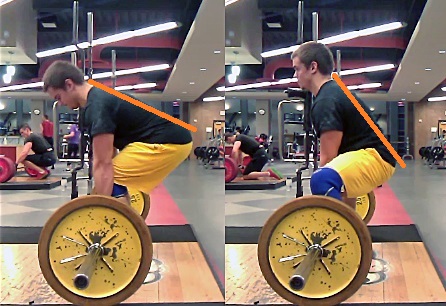Dead Lift

The Dead lift is the final lift
that is done in competition- this is because it
is the most taxing and works most of the body.
The barbell begins on the ground and
the lifter must lift the bar to a position where
the legs and and hips must be fully locked out.
Like the squat, there is more than just one
variation and form is also crucial.
Form and Bar path:
 Lots
of injuries can also be obtained by using
improper form when dead lifting. When
performing the movement, it is important to
keep a straight back as the weight is being
pulled up. Irregular curvature in the spine
can also lead to herniated disks. Bicep
injuries can also occur if there is any bend
in the elbow. A bend in the elbow creates a
moment around the joint, which places a
great deal of stress on the elbow which will
cause tearing at high weights. It is
important to keep arms completely straight
and to cause no tension in the biceps. It
helps to envision the arms as ropes. The
only action done by the arms is gripping the
barbell with one's hands. Lots
of injuries can also be obtained by using
improper form when dead lifting. When
performing the movement, it is important to
keep a straight back as the weight is being
pulled up. Irregular curvature in the spine
can also lead to herniated disks. Bicep
injuries can also occur if there is any bend
in the elbow. A bend in the elbow creates a
moment around the joint, which places a
great deal of stress on the elbow which will
cause tearing at high weights. It is
important to keep arms completely straight
and to cause no tension in the biceps. It
helps to envision the arms as ropes. The
only action done by the arms is gripping the
barbell with one's hands.
Bar path is similar to the squat in which a
linear bar path is desired. A straight path
means that all the work done by the body is
vertical and no energy is wasted moving the
bar horizontally.
Variations:
 The
dead lift's variations are broken up
into two different types: sumo dead lift
and conventional dead lift. Different
stances, angles,
and grips can be assumed but there is a
main distinguishing factor that
categorizes whether a lifter's set up is
sumo or conventional.
In a sumo dead lift, the legs are wider
than where the bar is gripped. In
conventional, the hands grip the bar
outside of where the feet are
positioned. Like the squat and wide grip
bench, sumo creates a wider stance which
shortens the range of motion. This does
not make the lift inherently easier
either, though. Sumo dead lifting allows
the torso to be more upright but tends
to put more strain on muscles such as
the quadriceps and othe The
dead lift's variations are broken up
into two different types: sumo dead lift
and conventional dead lift. Different
stances, angles,
and grips can be assumed but there is a
main distinguishing factor that
categorizes whether a lifter's set up is
sumo or conventional.
In a sumo dead lift, the legs are wider
than where the bar is gripped. In
conventional, the hands grip the bar
outside of where the feet are
positioned. Like the squat and wide grip
bench, sumo creates a wider stance which
shortens the range of motion. This does
not make the lift inherently easier
either, though. Sumo dead lifting allows
the torso to be more upright but tends
to put more strain on muscles such as
the quadriceps and othe r
leg muscles. A conventional dead lift
set up will force the the torso to be
bent over more, which involves more back
recruitment. Whether the lift is easier
or not also depends on the lifter's
personal strengths and weaknesses. r
leg muscles. A conventional dead lift
set up will force the the torso to be
bent over more, which involves more back
recruitment. Whether the lift is easier
or not also depends on the lifter's
personal strengths and weaknesses.
In case of additional interest in the
dead lift click Here.
|